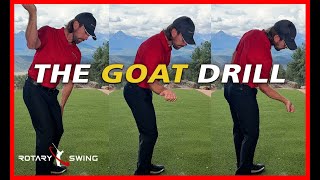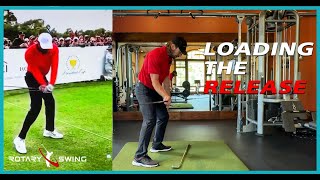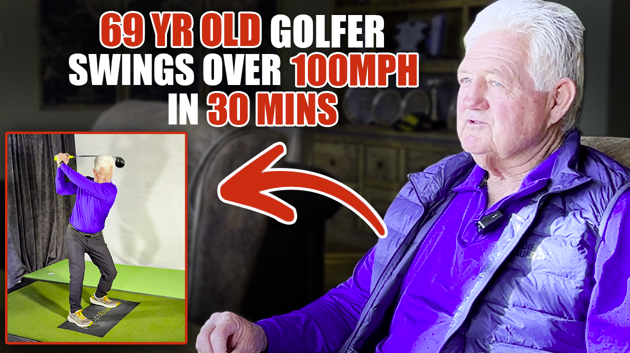You don't often hear much about the pinky in your grip, but there are some surprising influences that it has on your golf swing and whether you achieve a flat left wrist at impact.
In this video, I talk about the biomechanics behind the connection of your pinky on your left hand and the influence it has on tension in your swing and the impact position.
Are you flat or do you flip? The position of your left wrist at impact goes a long way toward dictating what type of ball striker you will be and the pinky has an influence on this position.
The Secret to the Golf Grip – The Pinky (Video Transcript)
I don’t consider there to be too many secrets in the golf swing, but there are certain fundamentals that are very important and often overlooked. As you learn to master the game over time, you pick up on things that may seem insignificant, but to another golfer may be a game changer. Understanding the nuances of the correct golf grip is one of those things.
This little nugget of golf wisdom is something I actually learned through my physical therapist who has an amazing understanding of the golf biomechanics. I know a lot of you disregard biomechanics of the golf swing because you see golfers who seem to have horrible golf swings yet still play very well. But, the reality is that biomechanics have a huge impact on your ability to play good golf and even something as small as the pinky of the left for right handed golfers can have a significant impact.
When a golfer takes his grip with the left hand, the pinky tends to be overlooked and the middle two fingers of the left hand tend to steal the show. This can be detrimental to your golf swing, especially if you tend to flip the club through impact. So, let’s do an experiment.
Take the middle two fingers and curl them and squeeze tightly and see where you feel the muscular tension. If you pay close attention, you will note that the tension from this muscular contraction travels all the way up your arm and even up into your head just behind your jaw. Very interesting and I’ll talk about why this is important in just a second.
Now, do the same thing with just your pinky. Interestingly, you will notice that you will really only feel tension in the bottom half of your forearm and it doesn’t travel up your arm into your neck. So, why is this important?

First of all, when you grip the club more securely with your pinky you reduce the tension in your left arm. As you well know, tension kills many otherwise great golf swings and robs you of clubhead speed. When you grip the club primarily just with your middle two fingers, you create tension immediately in your golf swing right from setup.
So, by training your grip to use the pinky a bit more from the beginning, you can reduce tension in your arms and shoulders and have a more fluid golf swing. This will take a little time to get used to but will be well worth it.
The other reason this is an important fundamental of the golf grip is because it helps with developing the flat left wrist that every “flipper” of the club desires in their golf swings. If you grip the golf club with just your left pinky, you’ll see that it’s actually quite easy to get into a nice flat left wrist position at impact because the pinky leads the way.
Now, take your grip with just the middle two finger and see how the tendency is to get the wrist into a slightly cupped, scoopy position at impact because of the different muscles used in the forearm.
Now, go back to just using your pinky by itself and note how gripping the golf club more snuggly with just the pinky firmly “locks” the wrist in this slightly bowed position, thus making it much harder to flip the club through impact.
Go back and forth a few times switching your grip between the fingers and note how your impact position (learn more about the correct golf impact position) improves and your tension in your arm and shoulder decreases the more you use the pinky.
Video Transcription: Stop Flipping the Golf Club
I don't consider there to be too many secrets in the golf swing, but there are certain things that you learn over time that have a unique and different influence on your golf swing, that you may not have been aware of before.
One of the interesting aspects of the golf swing, that's very often hotly debated, is the grip. The grip has been written about probably as much as anything else in the golf swing. It is an extremely important part of the golf swing.
I'm going to talk a lot more about the grip in just a moment, but one of the things I want to talk about is something that I learned from my physical therapist, actually. It has to do with, of all things, the pinky.
I don't really consider the pinky to be too important a part of my grip, in all reality! But the truth of it is, as you learn more about biomechanics and how they affect your golf swing, it actually has a dramatic impact on how you swing and grip the golf club.
What we're going to talk about today in this video is the pinky on the left hand.
When you take your grip, the pinky on the left hand, the golf club kind of sits in the cradle of that pinky just a little bit, as your hand folds over.
What happens a lot of times, because that pinky's not very strong, we tend to grip the club a little bit more in these two fingers. That seems like a pretty insignificant issue, but what happens when you grip the club with these two fingers...
I'm going to have you do a little test with me - take these two fingers, the middle two fingers, or you can even include your third one - and pay very close attention. As you squeeze these fingers together, the tension that you feel as it runs up your arm. What you'll notice is that it goes into a very interesting place.
First take these three fingers and squeeze them. Fold them down and squeeze them. Notice, as you squeeze, you'll feel tension in your forearm. It'll work up into your tricep, go up into your shoulder, and you'll actually notice all the way up into your neck that you can feel tension, right behind your jaw; pretty interesting. I'll talk about why that's important in just a second.
Now, take your pinky, fold it over, and just imagine that you're trying to grab - like a baby grabbing somebody's finger - right in the middle here. Right in this first joint. Fold it over, then relax all your muscles. Do the same thing.
You'll notice that if you leave these other three fingers relaxed and leave them out of the picture here and just fold your pinky over, that the only place you really feel the tension is down in your forearm and a little bit into your tricep, but it doesn't go up into your neck.

Why is that important? There are two reasons. First of all, when you're gripping the club more with your pinky, you reduce the tension in your neck. How many golfers have we seen centered over the golf ball like this, getting all tight and getting aggressive, and really wanting to squeeze it?
Then you look at a professional's golf swing and they look really relaxed, they've got a good hold. They always look like they're just going to hit a good shot. The relaxed grip, hands are soft, etc., etc.
It's interesting that having such a small, little detail changed about your grip can affect your entire golf swing. When we're tight up here, our whole body's going to be tight. Right in our neck and our shoulders and our upper torso, it's going to affect everything you do. It's going to limit your turn, it's going to make you swing quicker, you're going to lose your tempo, etc.
By tightening the grip just a little bit more, focusing more with your pinky - it'll take some training, because obviously a lot of our pinkies aren't very strong, or we have physical limitations in them, or what have you - but you'll have to start getting used to gripping the club a little bit more with that last finger, more so than just the middle two.
They obviously still grip the club, but you want to keep them a little bit softer relative to the pinky, so that the rest of your arm can be free and you'll just use these muscles here and not get the tension running all the way up into your shoulders and your neck and your jaw, to reduce that tension.
The second reason is, when you're coming into impact, obviously everybody at impact wants that flat left wrist; the body staying back behind the ball and the left wrist that's really flat as you come into impact.
If you take that pinky - again, we're just going grip the club mostly with your pinky - you'll notice that as you come into impact if you took these other three fingers off, that naturally flattens your left wrist, by just grabbing the club with just your pinky.
It's hard to flip the club a little bit like this, when just using your pinky.
Now take the club in your other two fingers, and notice how as soon as you grip it with just those two fingers, your wrist naturally gets into this cupped position, automatically.
Now if you go back to your pinky, let it sit on there properly, it gets a little flatter and it's really easy to get into this position. Grip it with these two fingers and it makes it really easy to flip the club through impact, which so many amateurs do. It makes it a lot harder to get into this position with a flat left wrist.
You kill two birds with one stone by just focusing on gripping the club with this first joint in your pinky. You'll have to take some time doing it, to start getting to the point where you feel just most of the work being done by the forearm, not so much into your shoulders, etc., etc.
As you do this, it'll pay off in big dividends because you'll get that flat left wrist you're looking for at impact, and it'll reduce the tension in your upper body, and it should help your golf swing and your impact position.
Watch part 2 now to see how you're moving your body in the opposite direction of the pros!



































































































































































































































































































































































































































































































